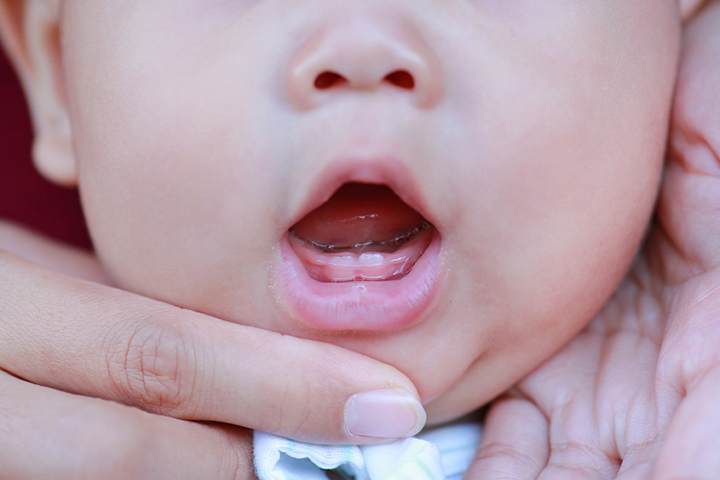
Image: Shutterstock
The picture of your child flashing their brand-new teeth stands out in particular. But unfortunately, it takes work to reach that milestone. Restless nights, sobbing, and excessive fussiness are the hallmarks of the teething process. So, parents need to know the correct method of preparing for teething and maintaining healthy gum. Continue reading to learn about the teething process and how to make it easy for your little one with some effective remedies.
What Is Teething?
Image: Shutterstock
When newborns begin teething, their teeth start to come through their gums. This development can cause discomfort, tears (from both you and the baby), and sleeplessness, even though it is a natural phase of a baby’s growth. Although babies can begin teething at any age between six and thirteen months, the very first teeth usually erupt approximately six months of age.
Typically, front incisors grow first. The bottom two front teeth will show up first, but occasionally, the top two may show up. Your child will be teething for a long time because their eight molars erupt around their first and third birthday. (1)
Symptoms of Teething In Babies
Image: Shutterstock
All newborns are unique. Their teething symptoms are also present. However, some babies don’t show symptoms of a new tooth ready to erupt. Others might exhibit the following signs:
1. Mood swings
Whatever you want to label them, fussy or grumpy, they are not themselves. Whines and shouts will take the place of giggles. And they are more clingy than usual.
2. Drooling
Bring extra bibs! Gums become red and swollen due to drooling. Also, when you open the baby’s mouth, the gums are prominent and red rather than small and pink.
3. Reduced Hunger
Eating can be difficult when one’s gums are inflamed, particularly for babies who consume solid foods. In addition, whenever a tooth is about to come out, they might not be able to eat properly.
4. Mouthiness
This type of mouthiness, distinct from talking back (which occurs later), describes children that nibble, chew, or even bite the objects around them, including their parents.
5. Gag Reflexes
Excessive drooling brought on by teething can trigger these reactions. However, you need not worry as long as your little one is not displaying any other symptoms of illness.
6. Low-Grade Fever
Although experts are still unsure whether babies can get a temperature during teething, if your baby does, keep an eye out for additional symptoms. Having your doctor assess a fever over 101° or lasting more than 3 days is best.
Remedies To Relieve Teething Pain
1. Sucking On A Cold Material
Image: Shutterstock
You can place a clean, damp towel and let it chill in the refrigerator; your baby will like chewing on that.
2. Teething Rings
This teething cure is well-known because it is effective. Your little one can nibble on a chewing ring, and the pressure it applies to the gums can help them feel better. To cool it down, parents can place it in the fridge.
3. Chewing Materials
Image: Shutterstock
Though you should spend money on a few teething toys, not all are created equal. For example, those tiny giraffe toys are incredibly well-liked. Pay attention to the materials used in teething toys and how simple it is to clean them. To avoid contamination from growing, ensure the toy is constructed of non-toxic materials.
4. Pain Relievers
Several medicines are safe for infants six months and older as a teething cure. For example, if your infant is cranky at bedtime, you can give them acetaminophen (Tylenol) or ibuprofen (Motrin). Then, when the teeth erupt, once for a few nights. You can find the safe dosage for your infant’s weight on the label. (2)
5. Give A Warm Shower
Image: Shutterstock
Simply massaging your baby’s gums may not always suffice to soothe them. Instead, consider giving your child a gentle and soothing bath. A warm bath can help relax their little body and serve as a pleasant distraction from any discomfort they might be experiencing.
6. Give Hugs
Make sure your teething infant gets ample cuddles and warm embraces. Teething babies often seek comfort in the loving arms of their parents. Find a comfortable chair and gently rock your baby. This not only offers both of you some valuable one-on-one bonding time but also provides comfort and solace in the midst of teething discomfort.
What To Avoid
- Stiff Toys
Health professionals also advise against using hard chewing toys made of plastic, metal, or wood. Stick to silicone teething toys instead, which are kinder to your baby’s gums.
- Frozen Chew Toys
While it might be tempting to offer your child a frozen teething toy or a chilled treat for relief, it’s important to note that freezing teething items can often do more harm than good. These frozen objects can be too cold and hard for your child’s sensitive gums, potentially causing discomfort rather than relief.
- Necklaces
Teething bracelets, necklaces, and other jewelry are not recommended by experts due to the risk of small pieces breaking loose and posing a choking hazard. Furthermore, these items can lead to oral injuries, illnesses, and, in rare cases, even strangulation.
As teething starts, parents frequently fear that their little one is in a lot of discomforts, but the good thing is that for the vast majority of kids, the process is relatively painless. In addition, you can take steps to relieve your baby’s temporary gum inflammation if they appear to be in pain. Just be sure you are aware of the warning signs of a more severe condition, and if you ever have any doubts, ask your child’s doctor for guidance.

















